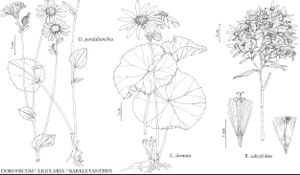Ligularia
Bull. Sci. Soc. Philom. Paris 1816: 198. 1816.
| Taxon | Illustrator ⠉ | |
|---|---|---|
 | Doronicum pardalianches Ligularia dentata Barkleyanthus salicifolius | Yevonn Wilson-Ramsey Yevonn Wilson-Ramsey Yevonn Wilson-Ramsey |
Perennials, 15–150+ cm (glabrous or scattered-hairy, especially distally [arachno-tomentose]; roots fibrous). Stems usually 1, erect. Leaves basal and cauline; alternate; petiolate (petiole bases dilated, ± sheathing stems); blades (basal and proximal largest, cauline smaller distally) palmately [palmati-pinnately] nerved, orbiculate to reniform [elliptic, lanceolate, oblanceolate, ovate], margins dentate [denticulate, serrate, dissected], faces glabrous or sparsely pilosulous (mostly on nerves) [glaucous; arachno-tomentose]. Heads radiate [discoid], in corymbiform [racemiform or spiciform] arrays. Calyculi 0 [1–2+ bractlets]. Involucres cylindric to campanulate, [3–] 16–28 mm diam. Phyllaries persistent, [5–] 8–13+ in 1–2 series, erect, distinct (margins interlocking) [connate at bases], mostly oblong or lanceolate to linear, subequal, margins usually ± scarious (tips greenish or reddish, not blackened). Receptacles flat to convex, smooth, epaleate. Ray-florets [0 or 1–7] 8–14+, pistillate, fertile; corollas (laminae prominent, showy) orange to orange-yellow or brick-red [yellow]. Disc-florets [5–] 12–100+, bisexual, fertile; corollas orange-yellow to orange, becoming brownish [yellow], tubes longer than cylindric throats, lobes 5, recurved, lance-linear; style-branches: stigmatic areas continuous, apices truncate or rounded-truncate. Cypselae (stramineous to brownish) ± ellipsoid [cylindric or fusiform], 5 [–10] -ribbed or nerved, glabrous; pappi persistent (fragile), of 40–100+, reddish [sordid, brownish, purplish], barbellate to barbellulate bristles ([shorter than] longer than cypselae). x = 30.
Distribution
Introduced; temperate Eurasia
Discussion
Species 125+ (1 in the flora).
Selected References
None.